-
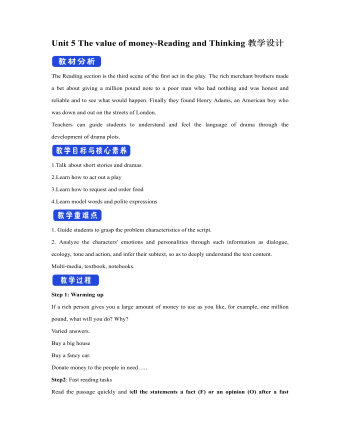
新人教版高中英语必修3Unit 5 The value of money-Reading and Thinking教学设计二
? Could you offer me some kind of work here?? I don’t want your charity, I just want an honest job.? Careless: I landed in Britain by accident.Step 7:Consolidation.? Find Henry? Roderick and Oliver were I .making a bet when they saw Henry, a poor young man. ? Know Henry? About a month ago, Henry was sailing and later he found himself carried out to sea by a strong wind. Fortunately, he 2.was spotted by a ship. And it was the ship that brought him to 3.England? Offer money to Henry ? Oliver and Roderick gave Henry a letter and told him that there was money in it. They 4.persuaded him to accept it, and made him 5.promise that it wouldn't be opened until 2 o'clock.Step 8:Language pointsa large amount of: a large quantity of; a great deal ofe.g. They bought a large amount of furniture before they moved their new house.make a bet: make an arrangement to risk money, etc. on an event of which the result is doubtful.e.g. We made a bet on the result of the match.permit sb to do something: allow somebody to do somethinge.g. My mother doesn’t permit me to ride in the street after it rained.by accident: as a result of chancee.g. I only found it by accident.stare at: look at somebody or something with the eyes wide open in a fixed gaze( in astonishment, wonder, fear, etc)to be honest: to tell you the truth; to be franke.g. To be honest, I don’t think we have a chance of winning.Step7 Homework:What do you think will happen to Henry? Will the bank-note help him or get him into trouble?
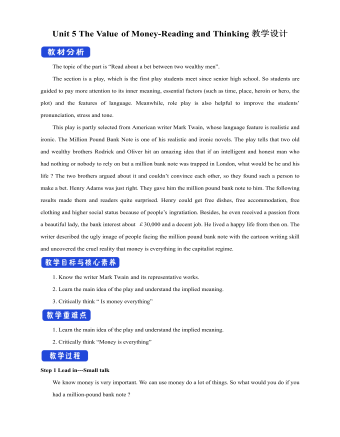
新人教版高中英语必修3Unit 5 The Value of Money-Reading and Thinking教学设计一
Everybody wants to get wealth.In today’s material world,making money or becoming wealthy symbolizes a person’s success and capability. Many people just make every effort, pay any price to attain greater wealth. With money,they can buy nice, large apartments in nice neighborhood. With money they can own luxurious cars. Wealth seems to bring all happiness in life.But is wealth the only road to happiness? Not really. There are many things in the world, which are beyond the means of money, such as friendship, love, health and knowledge. People are so preoccupied with struggling for money that they have no time or would not take the time to form or maintain friendship. What happiness can they feel living as lonely miserable creatures without love or friends in the world even if they accumulate tremendous wealth?In my opinion, people can’t do anything without money, but money is not everything. What money will bring you depends on your personal belief and goal in life. If you are kind enough to help others, especially the poor, money is a good thing to you. With it, you can do much more for the benefit of people and your country, and it will add to your own happiness. If you want money just for your own needs, you’ll never be satisfied or happy. In a word,you should have money spent for more people. Only then can money be the source of your happiness.Step 8 Homework4 students in a group, one acts Roderick, one Oliver, one servant and the fourth one acts Henry Adams, then listen to the tape, pay more attention to the difference between American English and British English in pronunciation, stress, tone.

新人教版高中英语必修3Unit 5 The Value of Money-Reading for Writing教学设计二
2. 您能看到, 我头发太长了。You can see that my hair is much too long.3. 无论什么时候, 只要您想回来就回来。Please come back whenever you want.4. 您仅有很少的头发要理! You only have too little hair to cut !5. 为您服务是我的荣幸!It is my honour to serve you!Step 9 Writing(Henry is walking down the street when he sees a sign for a place that cuts hair. He decides to have it cut. )H=Henry B=BarberH: Good afternoon, I’d like to have my hair cut, if I may. (The barber looks at Henry’s hair and continues cutting another man’s hair. ) Er, I’d really like a haircut. As you can see it’s much too long. B: (in a rude manner) Yes, I can see that. Indeed, I can. H: Fine, well, I’ll have a seat then. (He sits in one of the barber’s chairs. The barber turns to look at Henry. )B: It’s quite expensive here, you know! Are you sure you can afford it?H: Yes. I think so. (After his hair is cut, the barber tells Henry how much he must pay. Henry shows the barber the bank note. )B: Why Mr. . . (looks shocked)H: Adams. Henry Adams. I’m sorry. I don’t have any change. B: Please don’t worry! (wearing a big smile) Nothing to worry about! Nothing at all! Please come back whenever you want, even if you only have too little hair to cut! It will be my honour to serve you!Step 10 Pair workExchange drafts with a partner. Use this checklist to help your partner revise his/her draft.1. Are all the elements of a play included and in good order ?2. Do the character use suitable language ?3. Are the stage directions clear and useful ?4. Is the plot clear and exciting enough ?

新人教版高中英语选修2Unit 1 Science and Scientists-Discovering useful structures教学设计
The grammatical structure of this unit is predicative clause. Like object clause and subject clause, predicative clause is one of Nominal Clauses. The leading words of predicative clauses are that, what, how, what, where, as if, because, etc.The design of teaching activities aims to guide students to perceive the structural features of predicative clauses and think about their ideographic functions. Beyond that, students should be guided to use this grammar in the context apporpriately and flexibly.1. Enable the Ss to master the usage of the predicative clauses in this unit.2. Enable the Ss to use the predicative patterns flexibly.3. Train the Ss to apply some skills by doing the relevant exercises.1.Guide students to perceive the structural features of predicative clauses and think about their ideographic functions.2.Strengthen students' ability of using predicative clauses in context, but also cultivate their ability of text analysis and logical reasoning competence.Step1: Underline all the examples in the reading passage, where noun clauses are used as the predicative. Then state their meaning and functions.1) One theory was that bad air caused the disease.2) Another theory was that cholera was caused by an infection from germs in food or water.3) The truth was that the water from the Broad Street had been infected by waste.Sum up the rules of grammar:1. 以上黑体部分在句中作表语。2. 句1、2、3中的that在从句中不作成分,只起连接作用。 Step2: Review the basic components of predicative clauses1.Definition

新人教版高中英语选修2Unit 4 Journey Across a Vast Land教学设计
当孩子们由父母陪同时,他们才被允许进入这个运动场。3.过去分词(短语)作状语时的几种特殊情况(1)过去分词(短语)在句中作时间、条件、原因、让步状语时,相当于对应的时间、条件、原因及让步状语从句。Seen from the top of the mountain (=When it is seen from the top of the mountain), the whole town looks more beautiful.从山顶上看,整个城市看起来更美了。Given ten more minutes (=If we are given ten more minutes), we will finish the work perfectly.如果多给十分钟,我们会完美地完成这项工作。Greatly touched by his words (=Because she was greatly touched by his words), she was full of tears.由于被他的话深深地感动,她满眼泪花。Warned of the storm (=Though they were warned of the storm), the farmers were still working on the farm.尽管被警告了风暴的到来,但农民们仍在农场干活。(2)过去分词(短语)在句中作伴随、方式等状语时,可改为句子的并列谓语或改为并列分句。The teacher came into the room, followed by two students (=and was followed by two students).后面跟着两个学生,老师走进了房间。He spent the whole afternoon, accompanied by his mom(=and was accompanied by his mom).他由母亲陪着度过了一整个下午。

新人教版高中英语选修2Unit 1 Science and Scientists-Learning about Language教学设计
Step 7: complete the discourse according to the grammar rules.Cholera used to be one of the most 1.__________ (fear) diseases in the world. In the early 19th century, _2_________ an outbreak of cholera hit Europe, millions of people died. But neither its cause, 3__________ its cure was understood. A British doctor, John Snow, wanted to solve the problem and he knew that cholera would not be controlled _4_________ its cause was found. In general, there were two contradictory theories 5 __________ explained how cholera spread. The first suggested that bad air caused the disease. The second was that cholera was caused by an _6_________(infect) from germs in food or water. John Snow thought that the second theory was correct but he needed proof. So when another outbreak of cholera hit London in 1854, he began to investigate. Later, with all the evidence he _7_________ (gather), John Snow was able to announce that the pump water carried cholera germs. Therefore, he had the handle of the pump _8_________ (remove) so that it couldn't be used. Through his intervention,the disease was stopped in its tracks. What is more, John Snow found that some companies sold water from the River Thames that __9__________________ (pollute) by raw waste. The people who drank this water were much more likely _10_________ (get) cholera than those who drank pure or boiled water. Through John Snow's efforts, the _11_________ (threaten) of cholera around the world saw a substantial increase. Keys: 1.feared 2.when 3. nor 4.unless 5.that/which 6.infection 7.had gathered 8.removed 9.was polluted 10.to get 11. threat
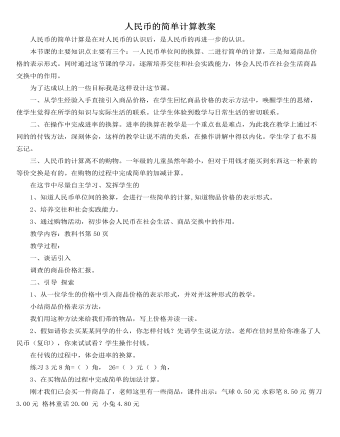
人教版新课标小学数学一年级下册人民币的简单计算教案
人民币的简单计算是在对人民币的认识后,是人民币的再进一步的认识。本节课的主要知识点主要有三个:一人民币单位间的换算、二进行简单的计算,三是知道商品价格的表示形式。同时通过这节课的学习,逐渐培养交往和社会实践能力,体会人民币在社会生活商品交换中的作用。为了达成以上的一些目标我是这样设计这节课。一、从学生经验入手直接引入商品价格,在学生回忆商品价格的表示方法中,唤醒学生的思绪,使学生觉得在所学的知识与实际生活的联系。让学生体验到数学与日常生活的密切联系。二、在操作中完成进率的换算。进率的换算在教学是一个重点也是难点,为此我在教学上通过不同的的付钱方法,深刻体会,这样的教学让说不清的关系,在操作讲解中得以内化。学生学了也不易忘记。
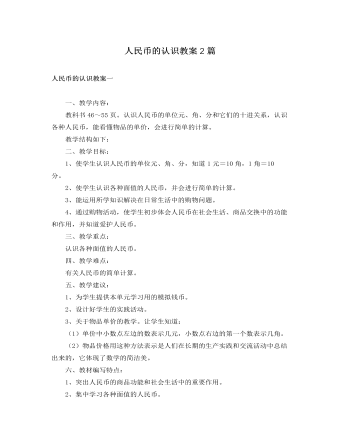
人教版新课标小学数学一年级下册人民币的认识教案2篇
出示例6挂图。教师试问:谁知道0.50元是几角?2.00元是几角?你是怎么知道?以元为单位小数点左边是几就是几元,右边第一位是几就是几角,右边第二位是几就是几分。1.20元是1元2角。35.90元是35元9角。(这部分知识学生知道它表示几元几角就可以了,至于1.20元是个什么数,怎么读、写不需要学生掌握)3、教学例7。(1) 课件演示例7第一小题。教师:0.5元是几角?(5角)0.80元是几角?(8角)学生回答。5角+8角是几角?(5角+8角=13角教师板书)教师问:多少角是1元?13角里面拿出10角还剩多少角?(3角)所以13角等于1元3角。教师板书:5角+8角=13角=1元3角。(2)例7第二小题(课件演示,提出问题:我买这两个气球要多少钱)学生尝试完成,然后提问:你是怎么想的?教师强调:元、角计算,只有在相同单位的情况下,才能相加。
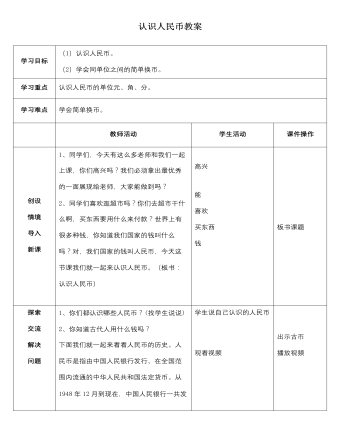
人教版新课标小学数学一年级下册认识人民币教案
教师活动创设情境导入新课 1、 同学们,今天有这么多老师和我们一起上课,你们高兴吗?我们必须拿出最优秀的一面展现给老师,大家能做到吗?2、同学们喜欢逛超市吗?你们去超市干什么啊,买东西要用什么来付款?世界上有很多种钱,你知道我们国家的钱叫什么吗?对,我们国家的钱叫人民币,今天这节课我们就一起来认识人民币。(板书:认识人民币)探索交流解决问题1、 你们都认识哪些人民币?(找学生说说)2、 你知道古代人用什么钱吗?下面我们就一起来看看人民币的历史。人民币是指由中国人民银行发行、在全国范围内流通的中华人民共和国法定货币。从1948年12月到现在,中国人民银行一共发行了五套人民币。分别是:1948年12月1日发行的第一套人民币;1955年3月1日发行的第二套人民币;1962年4月15日发行的第三套人民币;1987年4月27日发行的第四套人民币。还有1999年10月1日发行的第五套人民币也就是目前市场上流通的人民币。 请同学们仔细观察,这些钱你们都认识吗?(屏幕显示)人民币上有什么?(国徽)国徽是我们国家的标志,许多人民币上都有国徽,所以我们应该爱护它,不要故意损坏它。瞧,我们国家的人民币有这么多呢!有些是纸做的,叫纸币,(课件突出显示纸币)有的是金属做的,叫硬币。(课件突出显示硬币)2、特征辨认。师:这些人民币你们都认识吗?3、 师:那好,老师来考考你们这张人民币的面值是多少?你是怎么知道的?(同学们观察的真仔细)4、 看下面几张你都认识吗?5、 同学们学的真认真,老师中午回家要乘坐无人售票车,这种车要求自觉投币1元而不找零钱,老师只有一张10元的人民币,老师该怎么办哪?6、谁能帮老师换换钱?
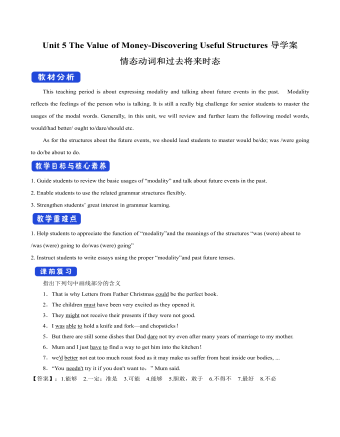
新人教版高中英语必修3Unit 5 The Value of Money-Discovering Useful Structures导学案
4.They were going to find someone to take part in their bet when they saw Henry walking on the street outside.[归纳]1.过去将来时的基本构成和用法过去将来时由“would+动词原形”构成,主要表示从过去某一时间来看将要发生的动作(尤其用于宾语从句中),还可以表示过去的动作习惯或倾向。Jeff knew he would be tired the next day.He promised that he would not open the letter until 2 o'clock.She said that she wouldn't do that again.2.表示过去将来时的其他表达法(1)was/were going to+动词原形:该结构有两个主要用法,一是表示过去的打算,二是表示在过去看来有迹象表明将要发生某事。I thought it was going to rain.(2)was/were to+动词原形:主要表示过去按计划或安排要做的事情。She said she was to get married next month.(3)was/were about to+动词原形:表示在过去看来即将要发生的动作,由于本身已含有“即将”的意味,所以不再与表示具体的将来时间状语连用。I was about to go to bed when the phone rang.(4)was/were+现在分词:表示在过去看来即将发生的动作,通常可用于该结构中的动词是come,go,leave,arrive,begin,start,stop,close,open,die,join,borrow,buy等瞬间动词。Jack said he was leaving tomorrow.
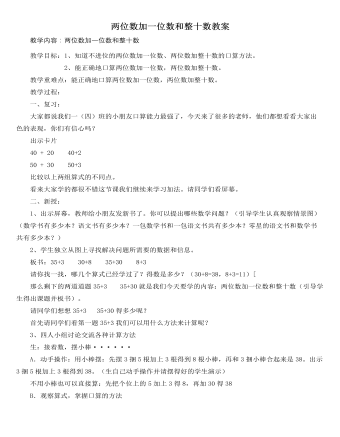
人教版新课标小学数学一年级下册两位数加一位数和整十数教案
二、新授:1、出示屏幕,教师给小朋友发新书了。你可以提出哪些数学问题?(引导学生认真观察情景图)(数学书有多少本?语文书有多少本?一包数学书和一包语文书共有多少本?零星的语文书和数学书共有多少本?)2、学生独立从图上寻找解决问题所需要的数据和信息。板书:35+3 30+8 35+30 8+3请你找一找,哪几个算式已经学过了?得数是多少?(30+8=38,8+3=11)[那么剩下的两道道题35+3 35+30就是我们今天要学的内容:两位数加一位数和整十数(引导学生得出课题并板书)。请同学们想想35+3 35+30得多少呢?首先请同学们看第一题35+3我们可以用什么方法来计算呢?3、四人小组讨论交流各种计算方法生:接着数,摆小棒······A.动手操作:用小棒摆:先摆3捆5根加上3根得到8根小棒,再和3捆小棒合起来是38。出示3捆5根加上3根得到38。(生自己动手操作并请摆得好的学生演示)不用小棒也可以直接算:先把个位上的5加上3得8,再加30得38B.观察算式,掌握口算的方法
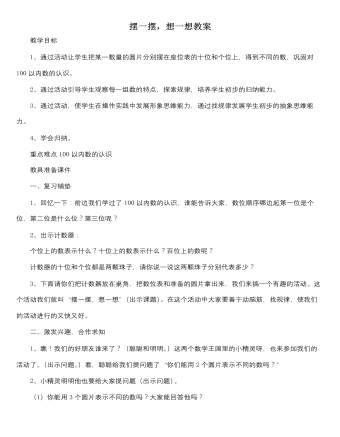
人教版新课标小学数学一年级下册摆一摆,想一想教案
每组4名小朋友3名在数位板上摆圆片,1名小朋友对摆出的结果进行综合、记录。3、全班一起用2个圆片摆出不同的数,引导学生讨论一下问题:(1)为什么两个圆片摆在个位上得到的数十2,而摆在十位上得到的数十20?(2)记录摆出的数是需要注意什么?(3)怎样才能知道摆出的数不遗漏?4、从刚才小朋友们用圆片摆数的过程,你发现有没有规律?下面我们不摆圆片,能不能在脑子里想摆圆片的方法,直接写出6个圆片,7个圆片,8个圆片,9个圆片都能表示哪些数?好,四个人合作,看哪一组填写的又快又好!学生分组活动:分别用3、4、5、6、7、8、9个圆片摆出不同的数。5、从以上我们所摆的圆片个数和写出来的数来看,同学们观察到有什么规律了吗?谁能说一说。
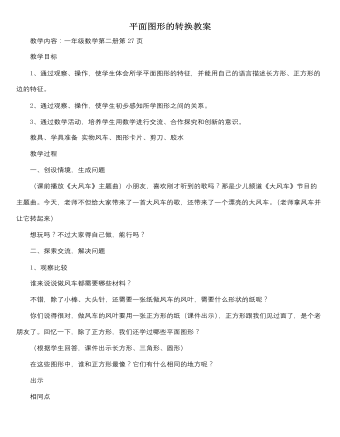
人教版新课标小学数学一年级下册平面图形的转换教案
教学目标1、通过观察、操作,使学生体会所学平面图形的特征,并能用自己的语言描述长方形、正方形的边的特征。2、通过观察、操作,使学生初步感知所学图形之间的关系。3、通过数学活动,培养学生用数学进行交流、合作探究和创新的意识。教具、学具准备 实物风车、图形卡片、剪刀、胶水教学过程一、创设情境,生成问题(课前播放《大风车》主题曲)小朋友,喜欢刚才听到的歌吗?那是少儿频道《大风车》节目的主题曲。今天,老师不但给大家带来了一首大风车的歌,还带来了一个漂亮的大风车。(老师拿风车并让它转起来)想玩吗?不过大家得自己做,能行吗?二、探索交流,解决问题1、观察比较谁来说说做风车都需要哪些材料?不错,除了小棒、大头针,还需要一张纸做风车的风叶,需要什么形状的纸呢?你们说得很对,做风车的风叶要用一张正方形的纸(课件出示),正方形跟我们见过面了,是个老朋友了。回忆一下,除了正方形,我们还学过哪些平面图形?
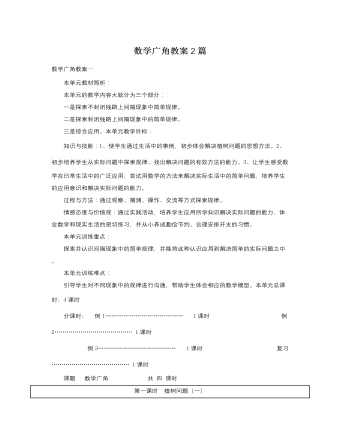
人教版新课标小学数学四年级下册数学广角教案2篇
一、初步感知间隔的含义1、请同学们伸出右手,张开,数一数,5个手指之间有几个空格?在数学上,我们把 空格叫做间隔,也就是说,5个手指之间有几个间隔?4个间隔是在几个手指之间?2. 其实,这样的数学问题,在我们的生活中,随处可见。谁能举几个这样的例子3、看图:在画面上我们看到春天桃红柳绿,到处是一派生机勃勃的景象,你们知道吗?3月12日是什么日子,这一天全国上下到处都在植树,为保护环境献出自己的一份力量。 出示图:这里从头到尾栽了几棵树,数一数,它们之间又有几个间隔呢?你发现了什么?谁来说一说?同时板书。4、那你能像这样用一个图表示出来吗?请你们选择一种动手画一画吧!5、汇报:画了8棵树,他们之间有7个间隔数,9棵树之间有8个间隔。……6、你发现植树棵树和间隔数之间有什么规律呢?(自己先想想,再把你的想法和伙伴们互相交流一下)。反馈:谁来说说你的发现?评价:哦,这是你的发现……你还能用一个算式来概括。边板书边说:同学们都发现了从头到尾栽一排树时,植树棵树比间隔数多1,(指表格),也可以写成两端要栽时,植树棵数-间隔数+1,间隔数=植树棵树-1。
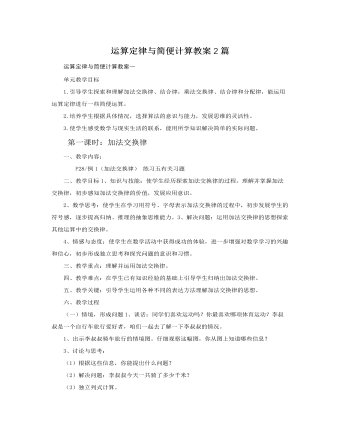
人教版新课标小学数学四年级下册运算定律与简便计算教案2篇
二、教学目标1、知识与技能:使学生经历探索加法交换律的过程,理解并掌握加法交换律,初步感知加法交换律的价值,发展应用意识。2、数学思考:使学生在学习用符号、字母表示加法交换律的过程中,初步发展学生的符号感,逐步提高归纳、推理的抽象思维能力。3、解决问题:运用加法交换律的思想探索其他运算中的交换律。4、情感与态度:使学生在数学活动中获得成功的体验,进一步增强对数学学习的兴趣和信心,初步形成独立思考和探究问题的意识和习惯。三、教学重点:理解并运用加法交换律。四、教学难点:在学生已有知识经验的基础上引导学生归纳出加法交换律。五、教学关键:引导学生运用各种不同的表达方法理解加法交换律的思想。六、教学过程(一)情境,形成问题1、谈话:同学们喜欢运动吗?你最喜欢哪项体育运动?李叔叔是一个自行车旅行爱好者,咱们一起去了解一下李叔叔的情况。1、出示李叔叔骑车旅行的情境图。仔细观察这幅图,你从图上知道哪些信息?
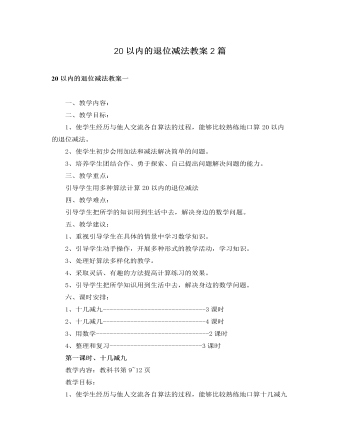
人教版新课标小学数学一年级下册20以内的退位减法教案2篇
一、揭题:小朋友们,今天我们一起来做练习。二、练习:1、第8题:这是一道计算题。(1)明确要求:看谁算得又对又快。(2)学生独立完成。(3)订正答案。(4)有错的学生,说一说计算顺序是怎样的,每一步的计算结果是多少?2、第9题:这是一道用数学的题。(1)看图,同位两个互相说说图意,并提出数学问题。(2)根据问题列算式解答。(3)订正答案。3、第10题:比一比。(1)明确要求,看谁先夺得红旗。(2)各小组派代表参加比赛。(3)对算得又对又快的学生提出表扬,并奖励给一个小标志。(4)再加入几组比赛题,尽量让学生多参与。4、第11题:这是一道用数学的题。(1)看图,说图意,提出数学问题。(2)列算式解答,指名板演订正。(3)说一说为什么用加法计算?5、思考题:小组讨论完成。一共12人,每两人之间插入一个女生,一共能插入11人。
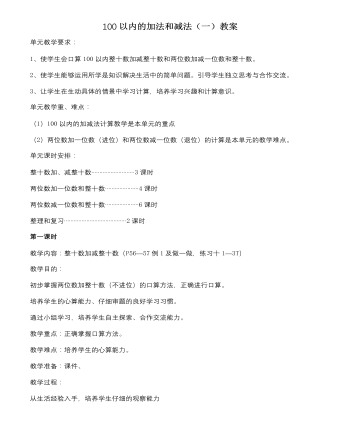
人教版新课标小学数学一年级下册100以内的加法和减法(一)教案
一、谈话引入,激发学生学习兴趣师:六一快到了,很多小朋友都想了很多的方式来庆祝,有的小朋友想去公园,有的小朋友想用自己攒的零花钱去买玩具呢,我们也和他们一起去看看吧!(电脑出示玩具店的货架和玩具的标价。)二、自主探索,提出问题。1、仔细看图,提出问题师:看货架上都有哪些玩具?你喜欢什么玩具?你从图上知道了哪些信息?(观察后指名回答。)课件出示:两个小朋友的对话师:货架下的两个小朋友在说什么?你知道了什么信息?(指明生说出题意)师:怎样才知道左边的小朋友买大象玩具后还剩多少元?右边的小朋友还差多少元呢?(用减法算)师:你知道这么列式吗?(师根据生回答板书算式)师:大家会算上面的算式吗?先在小组里摆一摆,算一算。2、分组操作,形成思维。学生摆小棒,教师巡回指导学生操作。3、信息反馈,抽象算法。师:大家摆出了上面两道题的得数吗?谁来说一说是怎样摆的?
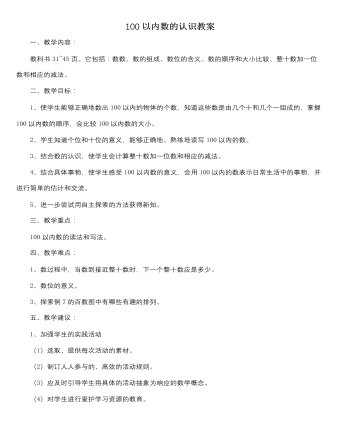
人教版新课标小学数学一年级下册100以内数的认识教案
(1)第1题:这是一道按顺序填数的题。根据要求在括号里填数。学生独立完成,订正。①所填数中,哪个数最接近100?②67接近60还是更接近70?62呢?(2)第2题:这是一道按要求排列数的题。把下面的卡片按从小到大的顺序重新排列,想一想:从小到大排列,要把什么样数放在最前面?什么样的数放在最后面?学生拿出数字卡片,在小组中完成。指名板演订正。(3)第3题:这是一道游戏形式的比较大小的题。帮小蜜蜂回家,学生独立完成连线。①大于60的数有哪些?②小于60的数有哪些?三、小结:谈谈这节课你的收获。作业布置:第八课时、练习教学内容:练习八4~8题。教学目标:巩固本单元所学知识。教学过程:一、揭题:这节课我们继续做练习,完成练习八余下的练习。三、完成练习:1、第4题:这是一道估数题。根据小青蛙说的话,估计一下它吃了多少只害虫。
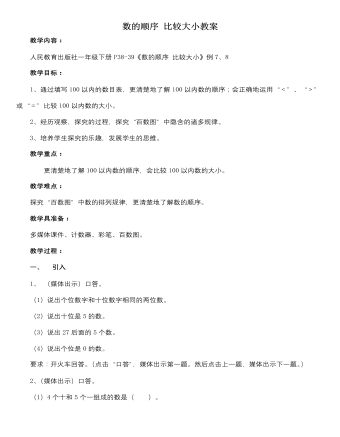
人教版新课标小学数学一年级下册数的顺序 比较大小教案
探究二:100以内数的大小比较。1、 (媒体出示课本第39页例8鸡蛋图。)师:看这鸡蛋图,谁知道哪边的鸡蛋多一些?你是怎么比较的?(学生可能回答:(1)根据鸡蛋图比较。(2)根据数的顺序比较。(3)根据数的组成比较。)(根据学生回答,点击○媒体出示答案。)2、 师:刚才我们看着鸡蛋图比较了两个数的大小,那如果没有图,我们会不会直接比较两个数的大小呢?我们请计数器来帮忙,谁来拨?(媒体出示计数器)师:谁能来说说每个数位上数的意义,再进行比较,说说比较的方法。(学生已经有了比较20以内数的大小的基础,教师引导学生在此基础上说出:28是由2个十和8个一组成,26是2个十和6个一组成,所以28>26;或者根据数数时28在26后面,所以28>26。)(点击表示28的计算器图,媒体出示28是由2个十和8个一组成;点击表示26的计算器图,媒体出示:26是由2个十和6个一组成;点击“26是由2个十和6个一组成”,媒体出示:28>26。)(师板书:28>26)
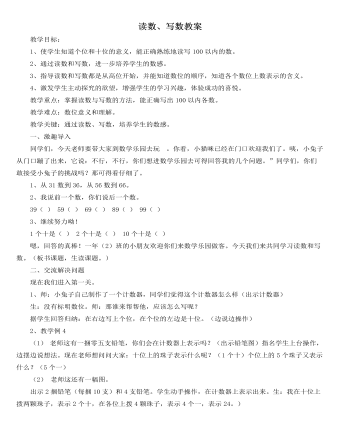
人教版新课标小学数学一年级下册读数、写数教案
教学目标:1、使学生知道个位和十位的意义,能正确熟练地读写100以内的数。2、通过读数和写数,进一步培养学生的数感。3、指导读数和写数都是从高位开始,并能知道数位的顺序,知道各个数位上数表示的含义。4、激发学生主动探究的欲望,增强学生的学习兴趣,体验成功的喜悦。教学重点:掌握读数与写数的方法,能正确写出100以内各数。教学难点:数位意义和理解。教学关键:通过读数、写数,培养学生的数感。一、激趣导入同学们,今天老师要带大家到数学乐园去玩 。你看,小猫咪已经在门口欢迎我们了。咦,小兔子从门口蹦了出来,它说:不行,不行,你们想进数学乐园去可得回答我的几个问题。”同学们,你们敢接受小兔子的挑战吗?那可得看仔细了。1、从31数到36,从56数到66。2、我说前一个数,你们说后一个数。

